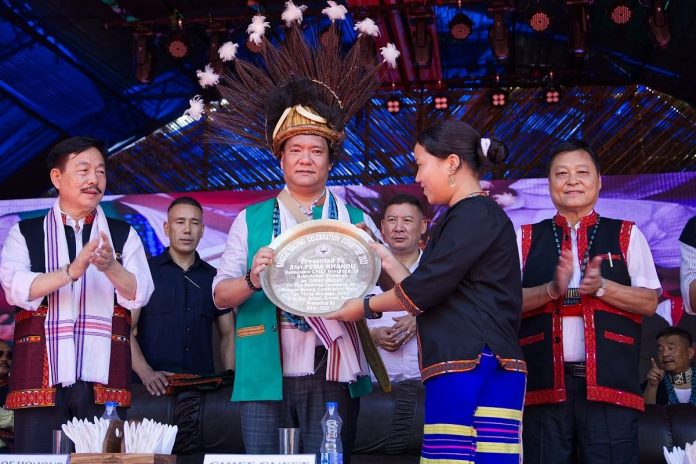Chief Minister Pema Khandu personally intervened to allay the misgivings of local people opposed to the project.
The Upper Siang multipurpose project is essential to keep the Siang river alive.
Arunachal Pradesh Chief Minister Pema Khandu has started the process of convincing people of Upper Siang and East Siang districts to allow the construction of a massive barrage across the Siang river, that flows through the two districts.
The construction of the barrage, part of a proposed 11,000 MW hydro-power project, is India’s answer to China’s plans to construct a 60,000 MW hydropower project on the Yarlung Tsangpo river at Medog County of Chinese-occupied Tibet.
India fears that China can hold India to ransom by cutting off flow of water to the Siang river at Medog to trigger water shortage and farm crises downstream.
China can also release huge quantities of water without notice from the proposed barrage at Medog, thus causing serious floods in Arunachal Pradesh, Assam and Bangladesh.
The Yarlung Tsangpo river, which originates at the Angsi Glacier that lies southwest of Mount Kailash and the Kailash Mansarovar in Chinese-occupied Tibet, enters Arunachal Pradesh at Gelling in Upper Siang district where it takes the name Siang.
The Siang river flows in a southerly direction through the Upper Siang and East Siang districts and enters Upper Assam’s Tinsukia district, where it joins the Lohit river to form the Brahmaputra which is the lifeline of Assam.
The Brahmaputra flows in a westerly direction till lower Assam’s Dhubri district before it takes a sharp southward turn to enter Bangladesh. It is then joined by the Teesta river that flows into Bangladesh from Sikkim and Bengal.
The Brahmaputra eventually becomes the Padma river in Bangladesh.
India has redesigned the 11,000 MW hydropower project on the Siang, in Upper Siang district, to include a buffer storage of nine billion cubic metres of water during monsoonal flow. This will frustrate any Chinese misadventure.
But the proposed hydropower project in Upper Siang district has run into rough weather due to vociferous opposition by local people.
Local people have boycotted meetings called by the district administration to explain the benefits of the project which will submerge two towns, including Yingkiong, the administrative headquarters of Upper Siang district.
The union government had requested Chief Minister Pema Khandu to personally intervene and allay the misgivings of local people opposed to the project.
Khandu started this process Thursday (7 September) by visiting Upper Siang district and initiating a dialogue with the local Adi community.
Khandu, accompanied by Deputy Chief Minister Chowna Mein, started their outreach by attending the Solung festival of the Adi community.
The Adis celebrate Solung after sowing the seeds of the winter paddy crop to seek a good harvest.
“I will meet community leaders and explain to them at length about the benefits of the Upper Siang Multipurpose Project,” said Khandu. He said he will explain to the people of Upper Siang what China is planning to do at Medog and how it can trigger a disaster downstream.
Khandu said he will explain to the people of the districts that the 11,000 MW project will be a bulwark against Chinese misadventure and will protect them (the people of the two districts) from any diabolic acts by China.
“I will be asking the local people to desist from opposing the project. Let the ground survey for the project take place and we will get a clear picture of what the project entails once that is complete. I am sure the people of Upper Siang will understand and will cooperate,” said the Chief Minister.
The Chief Minister added that the Upper Siang Multipurpose project is essential to keep the Siang river alive.
“If China chokes flow of water down the river or diverts the flow of water from the massive barrage at Medog (which lies just across the border with Arunachal Pradesh), the proposed barrage at Upper Siang will act as a buffer. And even if China suddenly releases excess water, the barrage in Upper Siang will be able to prevent floods downstream,” said Khandu.
The proposed Upper Siang multipurpose project will be India’s largest hydropower generating project. In December 2021, the Union Power Ministry tasked National Hydroelectric Power Corporation (NHPC) with executing the project which includes construction of a 300-metre barrage.
A pre-feasibility study of the project — five times the size of the largest existing hydro-electric project in India — was submitted to the Central Electricity Authority by the NHPC in December last year for its appraisal.
The buffer storage of nine billion cubic metres is equivalent to a year’s flow of water down the Siang river and will be enough to meet the water demand of communities living downstream.
It will also be enough to maintain the normal level of the Brahmaputra.
The Yarlung Tsangpo flows through 1,700 kilometres in Chinese-occupied Tibet, 920 kilometres as the Siang river and then the Brahmaputra through Arunachal Pradesh and Assam respectively, and 360 kilometres through Bangladesh.
Opposition by local communities, primarily over fears of displacement, inadequate compensation and environmental concerns, have derailed or delayed a few critical hydropower projects in Arunachal Pradesh.
“It is thus important to take local communities on board and allay their fears and misgivings. If things are explained to them patiently and rationally, and the benefits of projects pointed out to them, they will understand,” said Deputy Chief Minister Chowna Mein.
However, sources say that some self-styled environmental activists of suspected credentials have often misled local communities and fuelled protests.


